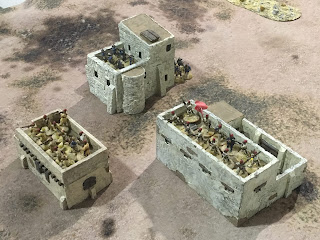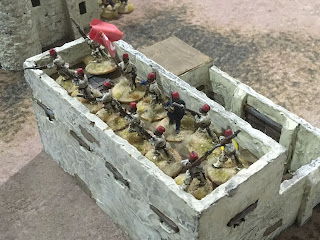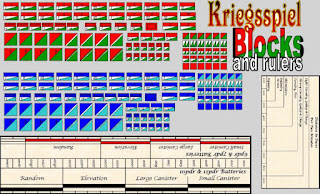I was very keen to get a game under my belt and so decided that the block armies would once again take to the table top in conjunction with the maps from the Axis and Allies Miniatures game. The ACW has made a welcome reappearance in the man cave and the scenario played was something I conjured up off the top of my head - so any resemblance to anything historical (or should be hysterical?) was purely coincidental but probably intentional....
The Atlanta campaign of 1864, culminating in the siege and fall of the city itself, consisted essentially of outnumbered Confederate forces being continually pushed back from defensive position to defensive position by a series of outflanking manoeuvres undertaken by the numerically superior Union forces. The scenario represented a typical action whereby the outnumbered Confederates were in a strong defensive position but were in danger of being turned and taken in the flank by a more numerous attacker.
To the best of my knowledge there is not a Rettendon Turnpike in Georgia but I will not let such a detail spoil the fun....
The Game Set Up
The overall situation at the start of the action - sadly the Confederate reserve of an infantry and a cavalry regiment are not visible as they are deployed to the rear of the town of Rettendon.
The playing area was 15 x 10 hexes and consists of two Axis and Allies Miniatures maps with a few 3D items of terrain added - mainly the Rawlplug fieldworks. The combatant forces were represented by my block armies. The game was very much by way of an experiment in respect of the scenario - for the first time I had consciously devised a plan of action for each side - so I wanted to take my time over the game and record what happened in greater detail than I would usually. The rules I used are Bob Cordery's Portable Wargame 19th Century set.
The Union initial deployment
Union Forces
1 x 2 Commander
6 x 4 Infantry
2 x 3 Cavalry
2 x 3 Artillery
Total Strength Points 38 - Exhaustion Level 14
The Confederates deployed in and around the town of Rettendon - note the fieldworks occupied by artillery and infantry and Beauregard's position in the centre of Rettendon
Confederate Forces
1 x 2 Commander (General Gaylord Beauregard III)
4 x 4 Infantry
1 x 3 Cavalry
2 x 2 Artillery
Total Strength Points 25 - Exhaustion Level 9
All units for both sides are rated as average and the artillery are equipped with smooth bore field weapons.
For identification purposes a unit with a black marker has fired for the turn and a white marker indicates a unit has suffered a hit. Blocks to be removed are stood on their end. If there is no block on its side but a unit has a white marker it means that the unit is opting to fall back rather than taking the loss.
For the most part the units followed the standard 4, 3, 2 approach for infantry, cavalry and artillery. I chose to make the individual Union artillery stronger rather than increasing the number available. It has no effect on their firing but it did mean they would last a little longer.
From the forces above you can see that the Confederates were outnumbered roughly 3:2 but with the advantage of the terrain and of course the fieldworks.
Somewhere, on the road to Atlanta....
"It won't be much longer..." muttered General Gaylord Beauregard III to himself as he surveyed the serried ranks of Yankee soldiery deploying in the distance. He knew it was coming but for all that he was grateful of the weeks grace afforded to him and his small command. The week had been well spent. The men had been able to rest and recover from the almost continuous marching they had been undertaking for what seemed like an age. For sure there work to be done - the fieldworks would not build themselves - but for the most part they were able to rest and recuperate, forage for food (especially important given the abysmal supply situation), make and mend but above all, be away from the shooting.
Beauregard cast his eye over his command for the hundredth time but was certain he had done all that he could with the forces at his disposal. There were lots of youngsters and the veterans were sadly dwindling in number but even so it was a good mix of experience and youthful enthusiasm. The real problem was that there was not enough of them, not enough to halt the blue tide that threatened to wash over them and certainly not enough to turn it back.
There was little pomp and ceremony within his command - for the most part the men had dispensed with that long since - but that did not mean they were undisciplined or in anyway unsoldierly. The men had the measure of their commander and he of them. In truth they were united in facing a common calamity; a calamity that would inevitably overwhelm and consume them all.
There was no unnecessary conversation, just the occasional question and patient answer or an oath muttered from behind a bedraggled beard - each man and boy lost in their own thoughts as they clutched at their weapons, their eyes to the front and the darkening horizon.
The silence was impressive.
Beauregard turned to his ADC, an impossibly young but dashing gentleman from Atlanta itself, eager for glory and whose ornate uniform, polished boots and magnificent black horse were in stark contrast to his own campaign worn attire and tired nag he was having to use, and addressed him directly. "Captain Mayhew if you please". The young officer threw an exaggerated salute to his General. "Captain please extend my compliments to all unit commanders (Beauregard knew that Captain Mathew would not possibly know their names given that he only been with the army for a little over the week they had been in Rettendon) and have them make ready. Our enemy is approaching." With the fire of excitement in his eyes the Captain again threw a salute to the general, jerked his horses bridle away and with a "Hiyah!" galloped away. Beauregard watched him go and then turned his own horse away and slowly walked back to the command post.
It would not be much longer.
Turn 1. After losing the initiative the opening move sees the Union force extending its frontage as to keep the Confederates guessing as to where the main point of attack will be. Note the artillery heading for the hills towards the bottom of the picture and the cavalry heading on a wide flanking move to the North.
Turn 2. The Confederate artillery opens fire at the oncoming bluecoats and inflicts minor casualties.
The Confederate position showing the artillery having fired.
Following the Confederate turn (they won the initiative but opted to stay put, content to await developments) the Union forces press onwards and outwards with the flanking force to the North supported by cavalry.
Turn 3. The Confederate artillery continues firing and inflicts more casualties on the advancing Yankees (who once again lost the initiative). The Union forces are getting much closer though and their artillery has finally reached the hills where it deployed for action.
Turn 4. Both sides artillery opens fire with the Union infantry again suffering casualties in the centre whilst the Confederate artillery comes under fire from the Yankee guns on the hills. Meanwhile both sides commence rifle fire with the Union coming off worse than their erstwhile opponents - all of whom having the benefit of cover.
Turn 5. The action hots up dramatically as the artillery fore from both sides scores some telling hits - the Confederates against the Union infantry whilst the Union artillery continue to pound the Rebel gun positions. The Union flanking force of infantry and cavalry skirts the wood at the North and is engaged by the sole Confederate mounted unit, desperately trying to keep the Yankee horseman at bay. Meanwhile the Union infantry in the centre is in danger of being overwhelmed as more casualties are suffered resulting in one unit opting to fall back.
Turn 6. Disaster! The Union artillery scores a devastating blow against the Rebel position and destroys both batteries in a storm of fire! (note the double 6 thrown for a hit and the double 1 for effect).
With their artillery destroyed Beauregard commits his infantry reserve to try and stabilise his Northern flank. His cavalry manage to fight their Union counterparts to a standstill but it is too little and too late as inexorably the Yankees turn his flank.
Turn 7. The Northernmost Confederate infantry are caught between Union forces to their front and rear and their only saving grace, albeit temporarily, is that they are in cover. Beauregard surveys his rapidly collapsing position and makes the only decision he can to salvage the situation. He orders the retreat and so those forces that are able to begin to break off the action and head to the Rettendon Turnpike to make their escape.
Turn 8. Endgame. The Southernmost Confederate infantry unit opted to fall back rather than sustain losses while from the North of the position the reserve infantry, although bloodied, was able to fall back on Beauregard's position. the surrounded troops in the woods would have to surrender in due course. the Union had forced the Confederates out of their position but at a cost. However, it was a cost that the Yankees could bear whereas the Confederates could not.
Both sides had reached their exhaustion level but the advantage clearly lay with the Union forces as the Confederates had decided to abandon the position. The Union however, were in no position to organise a pursuit.
Beauregard was exhausted in body and spirit. His men had given their all yet still it was not enough. His small command was now even smaller and and he felt unsure about how long this could continue - the endless marching, digging, fighting and marching again, always away from an enemy that, no matter how times you damaged them, still kept coming. The spectre of ultimate defeat loomed larger but for now he and his men would keep on until defeat consumed them.
Whatever happened to that "impossibly young but dashing gentleman from Atlanta"; so full of life and fire? Beauregard saw the magnificent black horse he owned standing riderless and breathing heavily at the side of the rode and knew the answer.
Overview
It was good to get a game fought at long last and the action went pretty much how I expected it to. If I am honest the Confederates could have made a more effective defence but it is difficult to see what else they could have done to slow the Union forces. Perhaps a mobile defence may have worked better although the Union holding attack proved rather more costly than they had reckoned on.
The rules worked well although I am embarrassed to admit to making a few mistakes with them - nothing major so I will just put it down to being a little out of practice.
I could think of worse ways to spend a bank holiday weekend.































